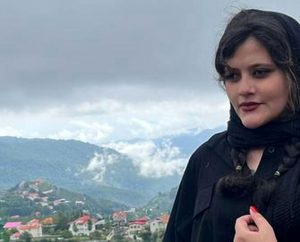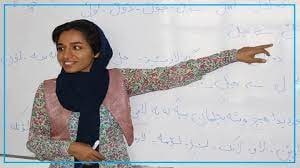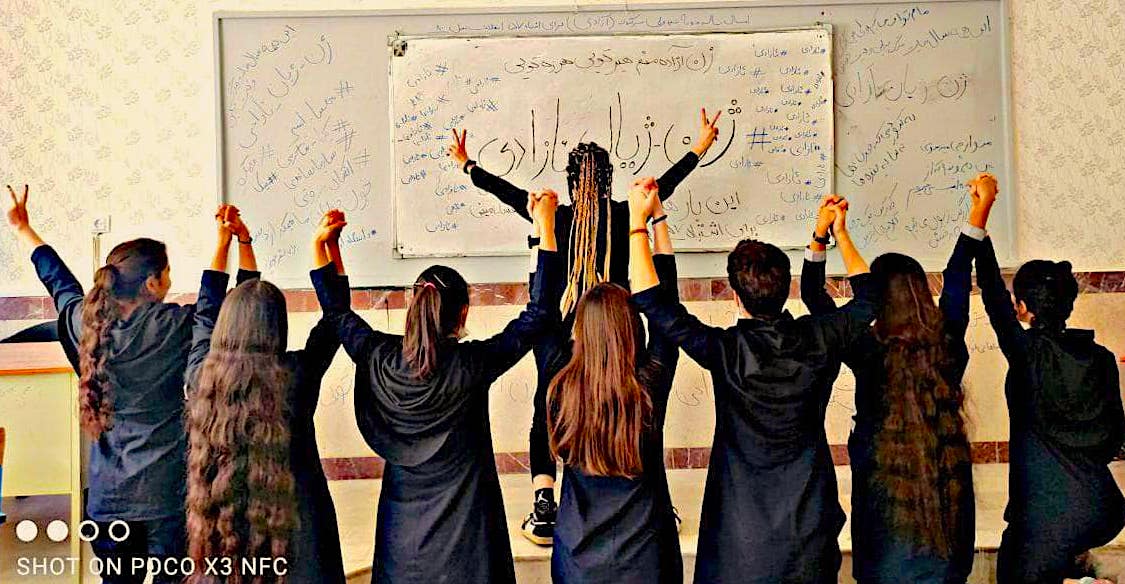6,514 Total views, 1 Views today
By Dr. Ahmad Mohammadpour
The torture and murder of Jîna (Mahsa) Amini, a 22-year Kurdish woman from the Kurdish city of Saqez, by Iranian regime forces on 16 September 2022 has marked a turning point in Iran’s women movement and the broader struggle for justice and freedom across the country.

Centered around the Kurdish slogan, Jin, Jîyan, Azadî (Woman, Life, Freedom), this has been the most widespread and sustained wave of protests in Iran since the country’s 1979 revolution. Yet despite the opportunity to de-ethnicize, de-provincialize, and de-centralize Persian feminism, Iran’s elite women activists are ignoring Kurds and Kurdish feminism and, indeed, are using Jîna’s murder to further their brand of Iranian feminism. Kurdish women, having loudly expressed their support for the protests, have been dismayed by the center’s appropriation of Jîna’s murder and its incorporation into the rhetoric of “Iranian women”. Mahsa’s Kurdish (second) name, “Jîna, provides a way to understand how her arrest and death are being contested.
Decolonizing approaches tell us that names and renaming have been a premeditated and deliberate strategy employed by settler colonialism designed to and predicated on the erasure of indigenous peoples, including their languages, cultures, and social structures. The settler-colonial process of renaming exhibits a range of meanings for settlers, the first of which is to strip the colonized of its memories and histories and (re)construct colonial stories about the colonized culture, land, and its inhabitants. Therefore, naming serves as a powerful vehicle for (re)narrating history and engraving the cultural and natural landscapes with desired meanings and reminders. The indigenous/colonized nations have resisted such colonial constructs by reverting the imposed names to set a boundary between their home and the world of outsiders/colonizers. Although the Iranian state has not entirely banned the use of Kurdish names, it has placed various bureaucratic restrictions on the use of Kurdish names as a strategy to assimilate non-sovereign communities. For example, in Kurdistan, the Iranian Census Bureau provides a list of acceptable names from which people must choose. Mahsa’s second (Kurdish) name testifies to the fact that such assimilatory measures have never troubled Persian intelligentsia and the dominant community at large[2].
In the eyes of Kurds, slogans chanted in Persian-majority cities such as “from Kurdistan to Tehran, oppression against women”[3] and “I will kill those who killed my sister”[4] signify the (re)appropriation of Kurdish women’s experience by their sisters of the dominant ethnie in an attempt to form an Iranianized gender identity premised on women’s ‘shared’ experience of oppression. For many Kurds, the construction of this purported shared experience has in fact been instrumental in the dominant ethnie’s assimilation project aimed at erasing the ethnic component of Kurdish women’s identity, or non-Persian womanhood[5].
Kurds as an ethno-national community have long been stigmatized as an existential threat to the national and territorial integrity of Iran[6]. Through universalizing Jîna’s death as a shared destiny of all Iranian women, regardless of their ethnic, religious, linguistic, and geographic backgrounds, the dominant ethnie has sought to de-territorialize and decontextualize the “uniqueness” of Kurdish women’s experiences and advance the idea that women’s rights in Iran will only be realized through political reforms and civil rights in light of individual freedom and secularism. However, such a conception of freedom has never extended to speaking and learning in one’s mother tongue and practicing the culture of non-Persians. In Jîna’s case, the activists of the dominant Persian ethnie have recalibrated the struggle against gender oppression to flatten the Kurdish historical struggle for their ethnic, religious, and linguistic rights. This, however, is only tactical and politically oriented, making use of Jîna’s death to repossess what the dominant discourse has long striven to control, that is, non-Persian minoritized communities and their cultures, memories, and histories.
While sovereign elites[7] found an instance for celebrating across Iran the ‘national unity and solidarity’ amid the atrocious exercise of violence by the state, the Kurds were cautious as to whether to embrace or distance themselves from the dominant narrative – a moment of celebration amid national mourning since it displayed the true face and character of “Iranianness”.
The Iranian state has long violated human rights in Kurdistan. By the same token, Jîna is not the only one who has fallen victim to IRI policies, nor is she the only symbol to represent the Kurdish feminist movement in Rojhelat, or the Kurdish region of Iran. As Jîna’s case demonstrated, the notion of “Iranian woman” forged by women elites of the dominant Persian ethnie functions as an ideal type whose intellectual properties are characterized and applied selectively by the women of the sovereign community to include only those experiences and practices compatible with the desired discourse – Persianism.
For instance, two other Kurdish women activists, Zara Mohammadi[8], an imprisoned teacher of Kurdish language, and Zeinab Jalalian[9], a political activist sentenced to life, have never received support or recognition by mainstream women activists. Zahra Mohammadi’s treatment by the regime neither captured the sovereign community’s attention nor was it condemned by her Persian sisters.

Zara, a board member of the Kurdish NGO Nojin and a volunteer Kurdish teacher, was arrested by the Iranian intelligence agency, Ettelaat, and sentenced to five years imprisonment January 8, 2022[10]. Her treatment reveals the foundational contradictions inherent in the IRI constitution[11]. Article 19 specifies that “the people of Iran enjoy equal rights, regardless of the tribe or ethnic group… race, language, and other such considerations shall not be grounds for special privileges”. At the same time, article 15 declares Farsi as “the official and common language and script of the people of Iran.” However, despite the stipulation in article 19, teaching and learning in the Kurdish language is not tolerated. The regime and the sovereign community justify and elevate the privilege of Persian language and culture, designating others as qowmi (ethnic), boomi, or mahali (local). Non-Persians’ cultural and linguistic self-assertions are considered ethnocentric or separatist (tajziyeh–talab). Condemnation of Zara’s arrest and imprisonment remains limited to the Kurdish region; not a single act of solidarity was organized outside of it.
An Iranian court sentenced Zeinab Jalalian to death on charges of “enmity against God” in 2008 in a sham trial that lasted only a few minutes. Her death sentence was then reduced to life imprisonment in 2011. Zeinab had been assisting women in Iranian and Iraqi parts of Kurdistan since 2000.

Despite suffering from various illnesses, she has been deprived of medical treatment and has not been granted a day away from the prison over the 750 days she has spent in jail. Jalalian was accused of taking up arms against the “sacred Islamic system”. The allegation against Zeinab of warring against the state (moharebeh) was never acknowledged by Persian women elites and her name has not been mentioned as an “Iranian woman” fighting the theocratic regime. It goes without saying that she is now serving the longest prison term of any female political prisoner in Iran[12]. This exemplifies how a statist, centralist, and nationalist perception of gender identity links inclusion into Persian sisterhood subject to a belief in the singularity of the nation. As long as the non-sovereign communities (regardless of gender, class, and other social affiliations) assert their identities, they are treated as Other by both the state and members of the sovereign community. The case of Zeinab reveals that the current women’s movement in Iran is not as radical, transformative, and subversive toward the existing unequal order as it might appear. Rather, it ensures that Persian-centric Iranian nationalist discourse remains intact.
Towards debunking the singularity of experience
The non-Persian women’s experiences and voices, intertwined always with ethnolinguistic demands, are addressed selectively by mainstream Persian women activists. One example of such a selective treatment is the high number of female suicides in the underdeveloped region of Ilam, often attributed to the region’s patriarchal structure. While patriarchy has a crucial role in gender oppression, the state’s fundamental role in the impoverishment of the region is constantly overlooked. Kurdish provinces (along with Baluchistan province) have the highest unemployment rates and have limited access to basic public services. A majority of sovereign women elites seem unwilling to focus on the state’s policies in this regard. To take another example, mainstream feminism in Iran ignores the suffering of women cross-border workers (Kolbers)[13]. Kurdish female kolbers carry heavy loads of goods on their backs across the border between Iran and Iraq; this activity has emerged in response to the ever-worsening economic life in Kurdistan and has become a hallmark of Kurdish life under the IRI.
The sovereign ethnie in Iran has established a racialized system of domination that operates through the distribution of political power and economic prosperity. This can be observed in poverty-stricken and underdeveloped non-Persian regions such as Kurdistan, Baluchistan, and Khuzestan, which have suffered decades of systemic and systematic economic marginalization and de-development[14]. For instance, over the last few years, eight [15] teenage Baluchi girls have drowned inside water ditches while collecting water for their households. Their tragic deaths captured no attention in the center, nor among Persian women activists. The state’s rendition of non-Persian ethnicities into securitized subjects and their regions into security zones has further added to the injury[16]. These constitutionally backed and institutionally entrenched inequalities are maintained through the sovereign community’s imposition of their cultural markers on Others[17]. These state-inflicted structural inequalities on non-Persians have rarely — if at all — been addressed in civil protests of the center, including those led by feminists.
The rise of the “Jîna movement” signifies not only a new era in the Kurdish struggle for fundamental rights but has also presented a modality of non-Persian resistance in which the fusion of subaltern nationalism(s), feminism(s), and decolonizing process(es) are clearly palpable. Though triggered – and largely led – by women, this unprecedented socio-political trend also poses an ontological and epistemic challenge to the feminism of the center, which can be explained by the fact that for marginalized and minoritized ethno-nations in Iran, gender oppression is always intersected with the ethnoreligious and linguistic forms of suppression.
The song “Baraye” (meaning “for/because”, in Persian) by Shervin Hajipour[18], a Persian singer, illustrates this phenomenon. Hajipour was inspired by tweets about Jîna’s death, and the song has been described by Persians as the anthem of the protests[19]. The song starts with “for dancing in the street, for being afraid to dance” and continues “for my mother, my sister, your sister, our sister; for changing the rotten brains; for shame, for lack of money; for a child looking for food in the garbage, and his dreams”. The song goes on: “for the polluted air and “Pirouz”, an endangered Iranian cheetah, “for the innocent prohibited dogs”, “for children of Afghanistan” and ‘for the government’s empty promises”. Nowhere in his song does Hajipour give any indication of ethnic and linguistic oppression.
Chia Madani[20], a Kurdish musician and songwriter, responded to Hajipour with a song of the exact equivalence “Bo” (meaning for/because, in Kurdish). He starts by thanking Hajipour for his “sweet and tender words” and then reminds him that “my wounds are older and deeper than yours, there are thousands of “for” in my heart”. Chia’s song points to the name “Jîna”, a name banned by the IRI government, which forced her family to choose the Persian name “Mahsa”. Chia mourns the fact that Jîna could not choose her name, neither in life nor after death. The song goes on “for” the sufferings of the oppressed people of the margins, “for” the arrested and executed teachers of Kurdish language, and “for” the fathers who had to pay for the bullets that were fired at their children.
Also inspired by Hajipour’s song, Fataneh Farahani, who is Persian, published an article titled 70 Feminist Reasons Why Women Protest in Iran Today.[21] Each reason starts with a “Baraye” (because / for), among which feature a dozen Persian activists such as “for the first Iranian feminist, Tahirih Qorratol’Ayn”, “for Nasrin Sotoudeh, Narges Mohammadi, Shiva Nazar Ahari, Sepideh Gholian, [and] Mahvash Sabet”. Although the article mentions the word Kurds twice – once as an ethnic group along with Blouchis and Arabs, and the second in reference to a Kurdish queer activist – Farahani’s list of “Iranian women activists” offers no indication of Zara Mohammadi and Zeinab Jalalian. This selective list indicates that women elites of the sovereign ethnicity either dismiss or incorporate the experiences of subaltern women into their desired nationalist feminist narrative.
According to Kurdish feminist activists, the goal of Persian feminism is not to make a radical change in the political discourse and “the regime of truth” but to either succeed within it or replace it with a system in which only civil freedoms are protected. Such a change or replacement, according to the feminism(s) of the periphery, will not necessarily result in an ethno-religiously and linguistically egalitarian and democratic model of governance. The feminism of the periphery believes that it has to fight four battles at once: one against the patriarchy, the second against a theocratic regime, the third against the feminism of the dominant ethnie, and the fourth against the ethnic-national oppression. The non-Persian feminists contest the feminism of the center for having benefited tremendously from affirmative action coming from their Persian privilege in taking political appointments, socio-economic mobility, educational progress, cultural representation, and more. They embrace Persian nationalist discourse regardless of its exclusionary and oppressive treatment of ethnic others. By centering feminism on gender alone and conveniently sidelining the impact of Persianness, identity, culture, and sovereignty on gender parity, Persian women co-opt the feminist space. They claim to carry the mantle of gender equality without reconciling it with its intersectionality and multi-dimensionality. It is only through advancing a negative critique of Persian and Persian privilege that a new mode of perception can become possible and result in an immanent emancipating effect.
The relationship of feminism of the center with the feminism(s) of the periphery (in its ethnoreligious and linguistic sense) resembles the relationship of white feminism to its black counterpart in places such as the United States. In his critique of white feminism, sociologist Eduardo Bonilla-Silva[22] (2006) has developed the term “color blindness” and defines it as a “means of maintaining racial inequality without appearing racist”. This concept can be extended to the way in which the sovereign ethnie in Iran has been “Other-blinded” toward non-Persians. Other-blinded discourse portrays Iran as an ancient and unified nation with a singular history, culture, and literary language, that is represented by and embodied in the Persian ethnie (see, Kia, 1998). Such a portrayal of ‘the nation’, in the words of Iranian scholar Mehrdad Kia[23], becomes possible only ‘by denying the existence of non-Persian identities’ (9–10). It is this mentality that defines all non-Persians anthropologically through the paradigm of romantic historicism and culturalism, which is based on the myth of the oneness of the nation (see, Ahmed[24], 2023). This view assumes the non-Persian world inside “Iran” as inherently masculine, local, tribal, folkloric, and culturally backward.
As with black feminists in the United States, the Kurdish feminist critique is predicated on the failure of mainstream feminism to come to terms with the fact that its version of feminism is concealed in ethnic supremacy. This centralist and statist approach to feminism takes the status quo for granted. When we look at this allegedly non-western, liberatory form of feminism, it usually rests on Persian women’s experience as a “normal experience” and the normative condition. It fails to include and acknowledge the ordeals of Kurdish, Baluchi, Arab, Azeri, Lurs, Gilaki, and Turkman women, among others. By excluding women of non-Persian background, it has directly or indirectly intensified the erasure of their individual experiences. Persian feminism as a worldview, therefore, speaks to a set of entrenched assumptions and practices that centers Persianness and naturalizes the Persian identity and value system as superior. This universalization of Persian feminism has been exported globally, and the consequences have been particularly devastating for women of subaltern nations in Iran.
This article invites critical reassessment of Persian feminism through what Adale Sholock has termed the “methodology of the privileged”[25]. To this end, it proposes a multinational and multicultural approach to feminism that encourages Persian feminists to interrogate Persianness and Persian privilege. For this critical approach to succeed, it has to adopt an inclusive and transformative approach that equally challenges Persian feminism’s racialized view of Iran, the implicit and explicit racism ingrained within it, and its discursive hegemony, as it does the male-centered societal system. It is only through taking such an all-encompassing framework that true feminist solidarity and mobilization across the polity can be facilitated.
Dr. Ahmad Mohammadpour is a US based socio-anthropologist from Rojhelat, Eastern Kurdistan, Iran. He holds a Ph.D. in Anthropology from the University of Massachusetts-Amherst and a PhD. in Sociology from Shiraz University. As a multilingual scholar, Dr. Mohammadpour has taught in English, Persian, and Kurdish in academic institutions such as Troy University, the University of Massachusetts-Amherst, Vanderbilt University, Bu-Ali Sina University (Iran), and Salahaddin University (Iraqi Kurdistan).
Mohammadpour’s research centers around the intersection of internal colonialism, minoritized ethno-religious communities, and political economy of de-development in the Middle East, with a focus on Kurds in Iran. He has written eight monographs and(co)authored over 60 academic articles in English, Kurdish, and Persian. His works on Kurdistan are widely considered models for ethnographic and grounded theory-based research in Iran. Mohammadpour’s research has thus far appeared in various international peer-reviewed journals such as Current Anthropology, Security Dialogue, The British Journal of Sociology, Third World Quarterly, Ethnicities, Quality & Quantity: International Journal of Methodology, The British Journal of Middle Eastern Studies, and International Journal of Qualitative Studies on Health and Well-being, among others.
[1] I would like to express my appreciation and gratitude to Dr. Mohammed A. Salih and Dr. Marouf Cabi for their careful reading of this article and their many insightful comments and suggestions.
[2] https://journals.sagepub.com/doi/abs/10.1177/1468796819853059
[3] https://www.youtube.com/watch?v=YS3nf7-28YA
[4] https://www.bbc.com/persian/iran-62953376
[5] Why “Jîna”: Erasure of Kurdish Women and Their Politics from the Uprisings in Iran (jadaliyya.com)
[6] Iran’s Protest and intercommunal interaction; a Kurdish perspective – Culture Project for Art, Feminism and Gender
[7] The sovereign ethnie in this article is referred to the Persian ethnic group which defines and imagines the identities of people of Iran as “Persian”, acting as a shill for Persian dominance-seeking nationalism.
[8] Unsilenced Voice- The Story of Zara Mohammadi | Washington Kurdish Institute (dckurd.org)
[9] https://www.amnesty.org/en/documents/mde13/3605/2021/en/
[10] https://hengaw.net/en/news/sanandaj-kurdish-teacher-and-activist-zara-mohammadi-started-prison-sentence
[11] https://www.constituteproject.org/constitution/Iran_1989.pdf
[12] Kurdish Political Prisoner Transferred to Jail Far Away From Family (iranwire.com)
[13] https://scholarworks.umass.edu/dissertations_2/2421/
[14] https://www.youtube.com/watch?v=ZOtvZNS7kv4
[15]https://women.ncr-iran.org/2022/06/02/5-children-drown-in-hootags/ and https://women.ncr-iran.org/2019/10/12/teenage-baluchi-girls-drowned-in-a-ditch-while-attempting-to-get-water/
[16] https://www.tandfonline.com/doi/abs/10.1080/01436597.2019.1695199
[17] https://journals.sagepub.com/doi/abs/10.1177/1468796819853059
[19] غیبت ستم اِتنیکی در دادخواهی مرکز گرا، از رادیو زمانه (radiozamaneh.com)
[20] Chia Madani برای FOR بۆ – YouTube
[21] Jadaliyya – 70 Feminist Reasons Why Women Protest in Iran Today
[22] Bonilla-Silva, Eduardo (2006), “Racism without Racists: Color-Blind Racism and the Persistence of Racial Inequality in the United States”, Science and Society 70 (3):431-434
[23] Kia, Mehrdad (1998), “Persian nationalism and the campaign for language purification”. Middle Eastern Studies 34(2): 9–36.
[24] Ahmed, Saladdin (2023), Critical Theory from the Margin: Horizons of Possibility in the Age of Extremism, Forthcoming.
[25] Sholock, Adale (2012), “Methodology of the Privileged: White Anti-racist Feminism, Systematic Ignorance, and Epistemic Uncertainty”, Hypatia, pp. 701-714
[1] Sholock, Adale (2012), “Methodology of the Privileged: White Anti-racist Feminism, Systematic Ignorance, and Epistemic Uncertainty”, Hypatia, pp. 701-714

